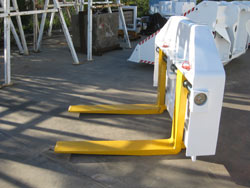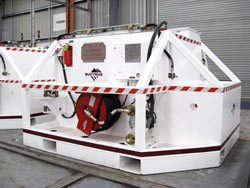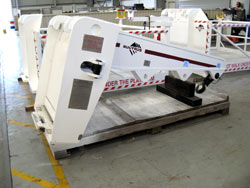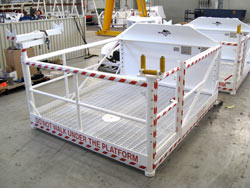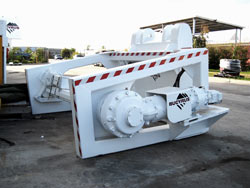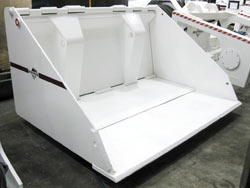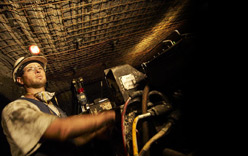Materials Transport
Note that the term "supplies" is often used instead of materials.
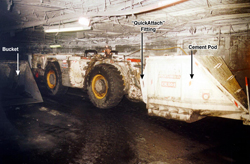 The most widely adopted materials transport system in
Australian coal mines comprises diesel powered tractors towing trailers, the
most common type of tractor being an articulated load/haul/dump ("LHD")
machine, normally fitted with a "quick
attach" scoop bucket with the "quick attach" system allowing the bucket to be
easily removed and replaced with other purpose designed attachments when not
towing trailers. Such attachments include forks for pallet handling, work
platforms for high work, cable or conveyor belt reelers, stone dusters, roof
bolters, etc.
The most widely adopted materials transport system in
Australian coal mines comprises diesel powered tractors towing trailers, the
most common type of tractor being an articulated load/haul/dump ("LHD")
machine, normally fitted with a "quick
attach" scoop bucket with the "quick attach" system allowing the bucket to be
easily removed and replaced with other purpose designed attachments when not
towing trailers. Such attachments include forks for pallet handling, work
platforms for high work, cable or conveyor belt reelers, stone dusters, roof
bolters, etc.
Originally trailers used in such systems were general
purpose flatbed trays, but increasingly use is being made of specialized
purpose designed trailers built for specific purposes or materials. While
removing some of the flexibility of the earlier systems it significantly improves
safety and efficiency in materials handling.
An alternative transport system is available where
articulated diesel prime movers fitted with U-shaped ends (or "tuning forks")
enable pods to be attached and transported throughout the mine in the fork
attachment - the pods replace the trailers in the system described above. The
prime movers lack the flexibility of being utilized for other functions when
not transporting materials, but the pods are considerably cheaper than trailers
and the prime movers less expensive than LHD's.
Increasing use is being made of palletizing or
containerising supplies where suitable, to facilitate handling of bulk
materials (e.g. loading all supplies needed for a set distance of mining
roadways into a purpose designed pod or container; stonedust in 1 tonne
capacity bulk bags instead of 25kg small bags) or packaging items previously
supplied loose (e.g. supply of road ballast in 1 tonne capacity bags).
While all these initiatives are aimed at improving
overall efficiency, it is important to ensure that they are designed to fit in
with available equipment or that suitable equipment is provided before they are
introduced into an existing operation.
It is noted that while rubber tyred equipment is
extensively used throughout the industry, caterpillar tracked vehicles are
also being introduced, particularly for handling large equipment such as longwall
shearers and supports.
Until the mid 1990's, all diesel vehicles used
underground were required to have exhaust "scrubbers" (essentially a water tank that exhaust
gases pass through before being released into the atmosphere) and protective
devices fitted to prevent the engine from potentially igniting gas. Trials have
been underway since that time to introduce standard diesel vehicles, as used on
the surface for use underground, provided such vehicles are restricted to
locations where gas should not be found (essentially in intake airways up to a
set distance from the face area) and they are fitted with devices to prevent
them being used in a non-approved manner. This is not yet accepted practice in
NSW.
